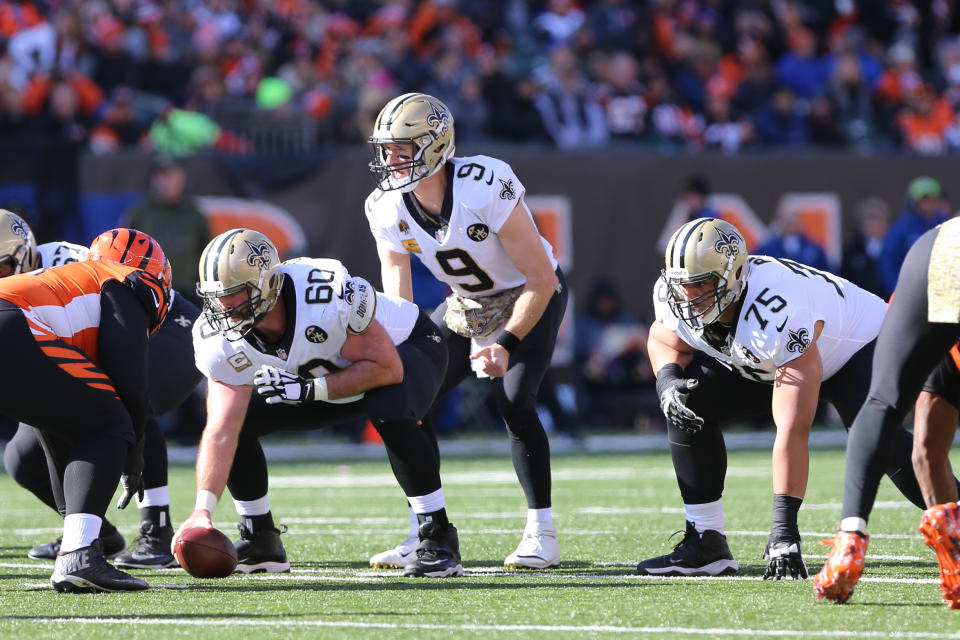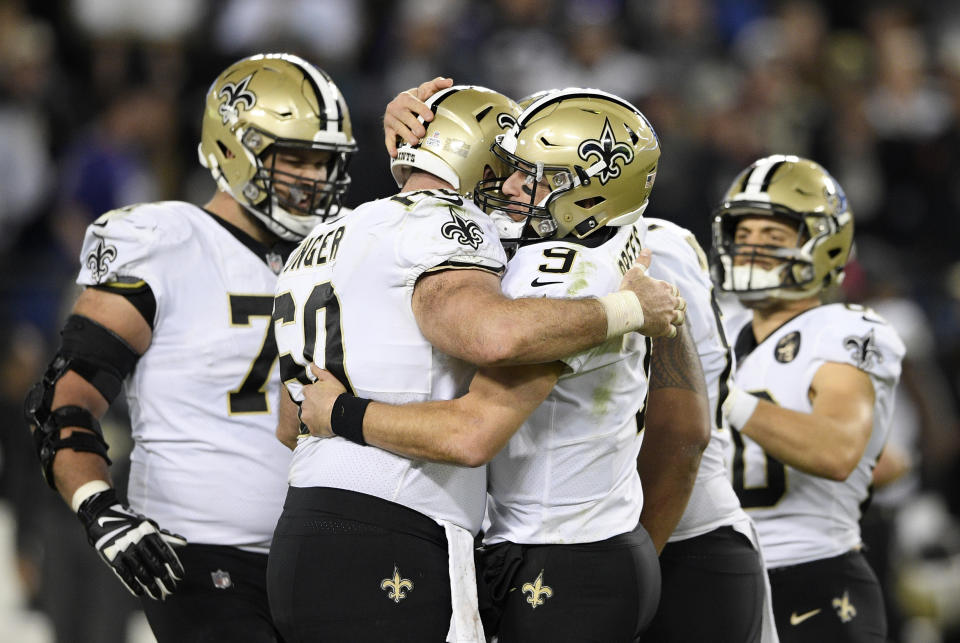Here's what you don't see about Drew Brees and the Saints' reascension up the NFL hierarchy
The news came as a shock. In 2015, one year removed from a Super Bowl victory and only a few weeks removed from what should have been a successful defense, the Seattle Seahawks made what the local paper called “one of the bigger blockbuster trades in Seattle history.”
They added star tight end Jimmy Graham, swiping the 28-year-old from the New Orleans Saints for a first-round pick and an offensive lineman who played only six regular-season games the year prior. New Orleans had dealt away Drew Brees’ favorite target in his prime and one of the most popular players in the city.
Why?
“It was a hard thing as a player,” says Zach Strief, then an offensive lineman for the Saints and since retired. Strief is still close with Graham.
Three years later, Graham is out of Seattle and the first-round pick, Stephone Anthony, is out of New Orleans. What remains, though, is Max Unger, the center who was reportedly not long for Seattle even if he weren’t dealt.
Unger has become the literal centerpiece of an offensive line rebuild that now has the Saints looking like the best team in the NFL. Since the start of October, Brees has 13 touchdowns and 30 incompletions. So if the pectoral injury to left tackle Terron Armstead is a matter of only a few weeks as reported, the group should be very dangerous in December and after.
“We do the yard work, the dirty stuff,” Armstead says. “We take pride in it.”
The Jimmy Graham trade was one of the best deals of the decade – for the team that gave away the superstar. Here’s a look at why the Saints’ offensive unit is so special.

Max Unger
If Brees is the brain trust, Unger is the nerve center. He has never been a big name, of course, but he’s seen it all. He was the third-longest-tenured player for the Seahawks when they traded him, having been drafted in 2009, so he has been on Super Bowl runs and he knows the league as well as any center. Teammates say he’s a wizard in meeting rooms, spotting tendencies as if he were a longtime coach.
“He’s an extremely smart person and player,” Armstead says. “Always identifying defenses and fronts. He’s probably the most cerebral player I’ve ever been around. His preparation is unreal.” He has missed only one game since his arrival.
Terron Armstead
Maybe the key to Armstead’s success was the “Fat Man Relays.” He was a shot-putter in high school but his track coach in Cohokia, Illinois, Leroy Millsap, used to run him in an exhibition race after meets, with pizza and hot dogs going to the winners. “Pizza will make kids run when they’re hungry,” Millsap said with a laugh.
Something worked: Armstead ran an offensive-line record 4.71 40-yard dash at the 2013 NFL scouting combine. Millsap says Armstead’s speed was less about the pizza and more about “a whole lot of power cleans.” Either way, now he’s a freak with size and speed. He hasn’t been healthy for long periods – and he is now dealing with that injury – but when he’s in there, good luck getting around a 6-foot-5, 305-pound blocker with 4.71 speed.
Andrus Peat
He is one of the trio that cemented the line after the Unger deal. Peat was the Saints’ top pick in 2015 – weeks after they acquired Unger – and he was only 22 in his first full season. He’s now coming into his own as a tackle, and he was a key to slowing Aaron Donald and Ndamukong Suh two weeks ago. “We needed to keep somebody in [Donald’s] face at all times,” Armstead says. “So that he would not know who was going to approach. Keep his head on a swivel.” Donald and Suh combined in the Superdome for zero sacks and two solo tackles.
Larry Warford
Remember when the Saints were so pass-dependent? Well, consider that the team ran the ball 44 times in Sunday’s win against Geno Atkins and the Bengals, and averaged more than 5 yards per carry. “We are getting enough production early on to be able to carry the momentum,” says Unger, “and being able to run the ball later in the game.” Some of that is because of Warford, the guard who signed a free-agent deal in 2017 and then made his first Pro Bowl. Being able to win road games on the ground will be a key to the Saints’ postseason, although right now it doesn’t look like they’ll have to leave New Orleans. Either way, it’s hard to travel anywhere against Warford. Unger calls him “a monster.”

Ryan Ramczyk
He was the team’s first-round pick in 2017, and he was a natural. He could take coaching and put it into practice faster than most linemen. “Some people, when you say you have too much weight on your outside foot, they have a lot of trouble transferring that into physical action,” Strief says. “It might take 500 reps or three years.” Ramczyk could do it right away. The tackle is so technically apt that Strief says, “You cannot push Ryan backwards.”
Drew Brees
What? You thought the offensive line was just about the blockers? Brees is a huge key to his own protection.
“If it’s a five-step drop, I know he’ll be at 6.5 yards,” Strief says. “Every time. I know when I pass set, at 6.5 yards I’m getting to the point where I don’t have to keep this guy anymore.” That preserves energy for a lineman and it also prevents needless holding calls.
“Drew’s not going to get up eight yards on a five-step drop,” Strief says. “As a lineman, that couldn’t be more valuable.”
Mark Ingram
Yep, the running backs help too. And it’s not just picking up the blitz and finding the gaps. Ingram is uniquely valuable for something else: his screens.
“A running back, on a screen play, has to get open in a way that’s tight enough so that he doesn’t out-leverage his linemen,” Strief explains. “As the running back gets wider, the MIKE linebacker is already gone – he’s already out-leveraged you. Mark Ingram is as good as there is at staying in that phase so we can keep our leverage.”
Want to see it in action? Here’s a video of Ingram lingering just long enough for Peat to get ahead of him and make a key block on a touchdown against the Bengals.
Alvin Kamara
A common perception is that Ingram is the power back and Kamara is the scat back. To the blockers, though, they’re pretty interchangeable. Kamara can bulldoze and Ingram can play in space. So the offensive linemen know what’s coming and the defensive lineman cannot be sure. “Defenses get no keys,” Strief says, “which makes life so much easier.”
The payoff
The cementing of the Saints’ offensive line in the years since the Unger trade has allowed the group to meet defensive hesitancy with offensive certainty. The group has only allowed nine sacks all season. Ingram has come back from suspension fresh, and Kamara is now in his second year in this offense. Adding “Swiss Army knife” Taysom Hill has stretched the playbook even more.
Then there’s the rock, Brees, who is always the same. Unger is his mental match. They don’t show nerves, no matter the situation, because they’ve seen it all. So every huddle is the same, whether in preseason or postseason, because they are both in there.
Brees is arguably the best NFL player never to win MVP honors. That could change this year, finally. Part of the reason is because of the less visible players who are most valuable to him.
More from Yahoo Sports:
• Dan Wetzel: Mexico City game teaches NFL a lesson
• Serena Williams’s GQ cover sparks outcry
• College cancels football after 53rd straight loss
• What to make of the latest Ohio State allegations?

